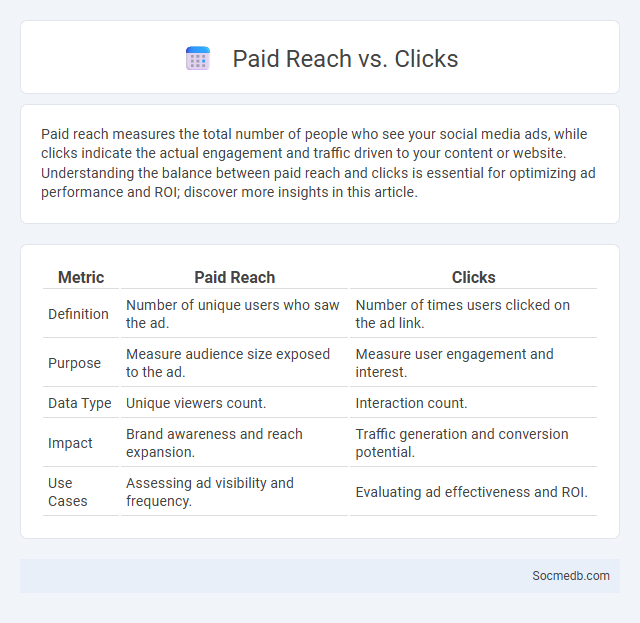
Photo illustration: Paid Reach vs Clicks
Paid reach measures the total number of people who see your social media ads, while clicks indicate the actual engagement and traffic driven to your content or website. Understanding the balance between paid reach and clicks is essential for optimizing ad performance and ROI; discover more insights in this article.
Table of Comparison
| Metric | Paid Reach | Clicks |
|---|---|---|
| Definition | Number of unique users who saw the ad. | Number of times users clicked on the ad link. |
| Purpose | Measure audience size exposed to the ad. | Measure user engagement and interest. |
| Data Type | Unique viewers count. | Interaction count. |
| Impact | Brand awareness and reach expansion. | Traffic generation and conversion potential. |
| Use Cases | Assessing ad visibility and frequency. | Evaluating ad effectiveness and ROI. |
Understanding Paid Reach: Definition and Importance
Paid reach refers to the number of unique users who see your social media content as a result of paid promotions or advertisements. This metric is crucial for marketers seeking to expand their audience beyond organic reach, enabling targeted exposure to specific demographics and interests. Tracking paid reach helps optimize ad spend by measuring campaign effectiveness and improving content strategies.
What Are Clicks in Digital Marketing?
Clicks in digital marketing represent the number of times users interact with an ad, link, or social media post by pressing on it, directly impacting your campaign's effectiveness. These interactions serve as key performance indicators (KPIs) for measuring engagement, conversion rates, and overall return on investment (ROI). Understanding the origin and behavior of your clicks allows you to optimize digital marketing strategies, improve precision targeting, and boost your social media campaign results.
How Paid Reach Differs from Clicks
Paid reach on social media refers to the number of unique users who see a sponsored post or advertisement, while clicks measure the actual interactions where users actively engage by clicking on the content. Paid reach focuses on exposure and visibility metrics generated through advertising budgets, whereas clicks indicate user interest and engagement levels with the ads. Understanding the distinction helps marketers optimize campaigns by balancing brand awareness with direct response objectives.
The Interplay Between Paid Reach and Clicks
Paid reach on social media directly influences the volume of clicks by exposing content to targeted audiences beyond organic followers. Optimizing paid reach through precise audience segmentation and ad placement increases the likelihood of engagement and click-through rates (CTR). Analyzing the interplay between paid reach metrics and clicks enables marketers to refine campaigns for higher conversion efficiency and better return on ad spend (ROAS).
Metrics That Matter: Evaluating Paid Reach vs Clicks
Paid reach measures the total number of unique users exposed to your social media ads, providing insight into your campaign's overall visibility. Clicks reflect user engagement by tracking the number of times someone interacts with your ad, indicating interest and potential for conversion. Analyzing both paid reach and clicks together allows you to optimize your advertising strategy for maximum return on investment and improved audience targeting.
Cost Implications: Paid Reach vs Clicks
Paid reach on social media platforms incurs costs based on impressions, often charged per thousand views (CPM), making it effective for broad brand awareness campaigns. In contrast, paying per click (CPC) targets user engagement, where advertisers are charged only when users actively click on ads, optimizing budget for direct response and conversion tracking. Balancing CPM and CPC strategies allows marketers to allocate spend efficiently, maximizing both visibility and measurable user actions within their social media advertising budgets.
Optimizing Campaigns: When to Focus on Reach or Clicks
Optimizing social media campaigns hinges on your primary objective: prioritize reach when brand awareness and audience expansion are essential, as this maximizes the number of unique impressions. Focus on clicks to drive targeted traffic and increase conversions, measuring engagement through click-through rates (CTR) and conversion metrics. Understanding these optimization strategies helps you allocate budget efficiently for campaigns on platforms like Facebook, Instagram, and LinkedIn.
Case Studies: Paid Reach and Clicks in Action
Paid reach campaigns on social media platforms like Facebook and Instagram demonstrate increased visibility by targeting specific demographics, resulting in higher engagement rates. Case studies reveal that investing in paid ads boosts click-through rates by up to 30% compared to organic reach alone. Brands leveraging detailed audience analytics achieve optimal ad placements, maximizing conversions through strategic budget allocation.
Common Mistakes in Measuring Paid Outcomes
Common mistakes in measuring paid social media outcomes include relying solely on vanity metrics such as likes and shares instead of conversion-focused data like click-through rates and cost per acquisition. You might also overlook the impact of attribution models, which can misrepresent the true value of your paid campaigns if not properly set up. Ignoring cross-channel effects and failing to track long-term customer lifetime value can lead to an incomplete understanding of your campaign's ROI.
Best Practices for Balancing Paid Reach and Clicks
Effective social media strategies emphasize balancing paid reach and clicks by targeting audiences with precise demographic and interest-based filters, ensuring advertisements reach potential customers most likely to engage. Utilizing A/B testing on ad creatives and copy helps refine messaging to maximize click-through rates while controlling costs. Monitoring key metrics like cost per click (CPC) and conversion rates allows for dynamic budget adjustments, optimizing the return on ad spend (ROAS) for campaigns.
 socmedb.com
socmedb.com